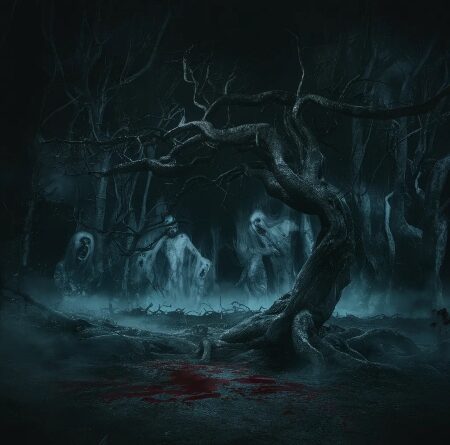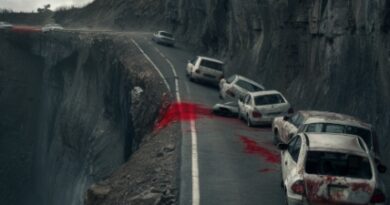Aokigahara Forest: Japan’s Creepy Suicide Forest
It is considered one of the most haunted places on earth. Even if you believe that ghost stories are reserved only for the cinema screen and not for reality, one fact cannot be ignored: this place, which offers a particularly threatening setting, attracts dozens or hundreds of people every year, who come with one with the aim of ending their lives. This is the chilling story of Aokigahara Forest in Japan, also known as “The Suicide Forest”. Aokigahara Forest story is about menacing trees, ghosts, broken compasses and everything that could be the basis of a really good horror movie, which unfortunately takes place in reality.
What Is Aokigahara Forest?
The Aokgahara Forest is located at the foot of Mount Fiji, on its northwestern side, and is also known by the locals as the “Sea of Trees” due to the huge amount of trees there and their density. The forest stretches for about 30 kilometers: Some parts of it attracts tourists, many others don’t. For example, on its western side you will find some beautiful caves, covered in ice in the winter months. Several routes depart from the forest to popular destinations around Mount Fiji. Unfortunately, many who visit here don’t look for Aokigahara Forest tour. And nor taking a walk in the forest or having a family picnic.
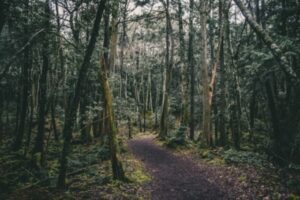
Aokigahara Forest is considered the second place in the world in the number of suicides there, after the Golden Gate Bridge in San Francisco. It is estimated that since the 1950s, at least 500 people have chosen to end their lives there – usually by self poisoning or hanging from one of the trees. Every year dozens of bodies are found throughout the suicide forest, and the traces of some of the people who entered there have not yet been found. In 2003, for example, no less than 105 bodies were found here. The “suicide season” in the country is around the month of March, with the main estimate being that the fiscal year in Japan simply ends at this time. Before the holidays, every year, delegations of law enforcement officers, Japanese forest rangers and volunteers go out to find Aokigahara Forest real bodies.
The Goal: Stopping Aokigahara Forest Death Count
One important fact that should be mentioned is the Japan is a country that is known for its traditionally high suicide rates. It started back in years past, when in samurai culture suicide was considered an act of heroism compared to the alternative of being defeated in battle. Today, the country’s suicide rate is the highest among industrialized countries, with about 20,000 suicides per year. The authorities in Japan, of course, are obviously trying to fight this and one of the tasks is to reduce the reference to the threatening forest as a “suicide forest”. This is not really a simple task due to the fact that the forest became famous mostly in these circumstances. In the 60’s of the last century, a successful Japanese suspense writer named Seicho Matsumoto placed at the center of the plot of his successful book “Tower of Waves” a hero who commits suicide in the forest. In the “Complete Suicide Guide” from 1993 – there is such a text – it was described as the ideal place for suicide.
Since 2011 there are no publications about the number of Aokigahara Forest deaths, due to the thought that such reports might encourage people to choose this sad way to end their lives: the data shows that a very significant part of the people who commit suicide in the forest come from other parts of Japan – You can get to Aokigahara Forest from tokyo in around 90 minutes drive – but also from other countries.
The desire of the Japanese authorities is to brand the forest as a nature site, rather than a Hell on earth. At the entrance to the forest you will find a sign in Japanese, asking visitors to reconsider their decision: “Life is a precious thing given to you by your parents. Think again, calmly, about your parents, your brothers and your children. Don’t worry alone, talk to us.” The sign was signed with a phone number to receive psychological help in emergencies. In various places in the forest you will find additional signs, in Japanese or English. This is alongside active actions that should make it difficult for those who wish to end their lives, such as railings on the bridges scattered throughout the forest.
What Makes Aokigahara Forest So Scary?
Over the years, some horror stories have been linked around Aokigahara Forest history. The local belief speaks of the bodies of the dead of the forest are still there. Some believe that the place has unique energetic characteristics, which means that the spirits and demons are “blocked” here and do not pass to the next world. According to the belief, you can come across Yurei here, the Japanese name for ghosts, who, as we learned in horror movies – have unfinished business in this world.
These are ghosts of elderly people who were brought to Japan’s Aokigahara Forest by their relatives, some would say thrown into the forest, as part of the controversial chant of “Ubasute” (loosely translated: “abandon the old woman”). The idea here is chilling: in families that have trouble feeding enough mouths due to their size or economic situation, the young men take the older women to the mountain, forest or other deserted place and leave them to die of hunger, dehydration or in other ways. It can be seen as euthanasia or a gruesome act, and it can be argued that it is nothing more than a folklore story – but according to local belief, it is well connected to Aokigahara Forest of japan. Others will claim that these are the spirits of those who chose to end their lives there. According to another myth, the forest is a dwelling place of Tengu, a demon in the form of a bird.
The fact that compasses do not work in large parts of the forest may contribute to these thoughts, but the truth is that it has a rather simple geological explanation: the soil around the forest is actually lava that has hardened, as a result of the eruption of the Fiji volcano in 864 AD, which contains a high amount of iron. Electrical devices loaded with iron, such as compasses, may therefore go crazy. Despite the common myth in places like this, cell phones and internet actually tend to work here.
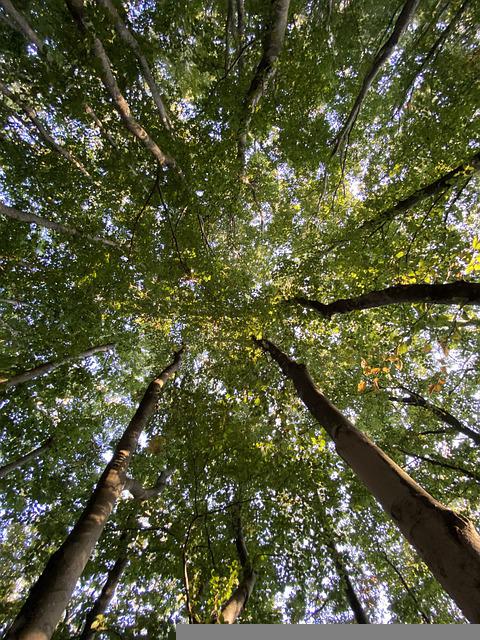
Whether the ghost stories attributed to the Aogihara Forest are true or not, the fact that this is a particularly creepy place cannot be ignored. The dense trees create an intimidating feeling. They seem to surround the visitors, most of them grow at odd angles, blocking the rays of light from reaching the ground. It is very easy to get lost in the forest, and according to reports from visitors who have been here, the imagination works overtime.
Walking at night in Aokigahara Forest is creepy, and especially when you are alone or lose your tracks. It is very easy to get lost here due to the dense trees, rocks and scenery that seems to repeat itself. In fact, it is said that about one kilometer into the forest the traces of people who stayed there start to disappear. The personal belongings that do come across indicate people who have already abandoned the forest. Some retraced their steps, others apparently ended their lives.
And there is also the issue of silence. There are forests where we occasionally hear birds chirping or other noises. In the forest of suicides, you often encounter dead silence, literally. The density of the trees contributes to this, probably also the lava soil that replaces the familiar rustling of trees from horror movies. This is perhaps one of the reasons why a local musician named Kiuchi Watanabe decided a few years ago to play various songs, for example “Imagine” by John Lennon, through speakers in his shack, to break the silence or try to inspire optimism in the visitors. In some cases, he simply plays himself With the guitar and singing. According to his reports, quite a few people who came to the forest with the intention of committing suicide have retraced their steps, to some extent thanks to that music.
The Aokigahara Forest In Culture (And Horror Cinema)
On the one hand, estimates are that the number of suicides in the notorious forest has decreased in recent years. On the other hand, its myth as a threatening location continues to exist. In 2018, YouTube star Logan Paul uploaded a video of his visit to the woods, which shockingly included a photo of the body of a man who commited suicide there. The video naturally drew harsh reviews, so Logan had no choice but to delete it and write an apology. Along with TV shows, songs, games and other content, cinema has embraced the Aokigahara forest – and it’s not hard to understand why.
We can mention some movies about aokigahara forest. In 2015, the drama “The Sea of Trees” by the controversial director Gus Van Sant was presented at the Cannes Film Festival. The film is about an American teacher (Matthew McConaughey) who comes to the forest to end his life, meets a Japanese citizen who is there for a similar purpose. From the moment the two become friends and decide to go back on their decision, it becomes a kind of survival journey. The film received many negative reviews, including boos at the Cannes Film Festival.
Grave Halloween (2013)
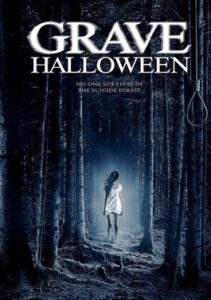
In 2013, we got an Aokigahara Forest movie that puts the horrific nature of this place at its center: “Grave Halloween.” This small movie focuses on Maiko (Kaitlyn Leeb), a college girl just lost her mother, who committed suicide in the forest. With a bunch of friends, she visits the woods to find the body, reveal the forest’s secrets, and, as one can expect: make a documentary about the forest (but don’t worry, it’s not a 100% found footage film). We haven’t seen it yet, so stay tuned.
The Forest (2016)

A bigger movie set in Aokigahara is “The Forest” (2016). The film tells the story of a young American woman, who goes in search of her twin sister who was last seen near the forest (Natalie Dormer from “Game of Thrones” in a double role) and comes across, Of course, with hallucinations, ghosts and other surprises that the forest holds. The work on the film began when David S. Goyer, later the producer of the film, read about the forest and was surprised to find that a horror film had not yet been made about it. He proposed the idea to Jason Zada, later the director of his film The first, who was immediately enthusiastic. He visited Aokigahara Forest in Japan and described the experience as particularly frightening.

